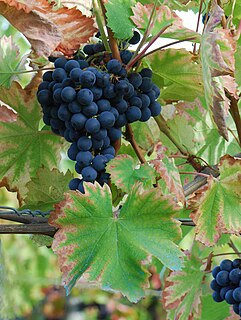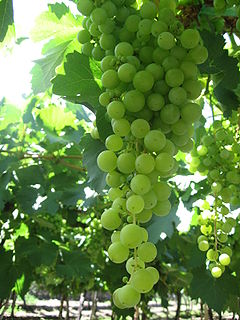
Riesling is a white grape variety which originated in the Rhine region. Riesling is an aromatic grape variety displaying flowery, almost perfumed, aromas as well as high acidity. It is used to make dry, semi-sweet, sweet, and sparkling white wines. Riesling wines are usually varietally pure and are seldom oaked. As of 2004, Riesling was estimated to be the world's 20th most grown variety at 48,700 hectares, but in terms of importance for quality wines, it is usually included in the "top three" white wine varieties together with Chardonnay and Sauvignon blanc. Riesling is a variety which is highly "terroir-expressive", meaning that the character of Riesling wines is greatly influenced by the wine's place of origin.

Chenin blanc is a White wine grape variety from the Loire Valley of France. Its high acidity means it can be used to make everything from sparkling wines to well-balanced dessert wines, although it can produce very bland, neutral wines if the vine's natural vigor is not controlled. Outside the Loire it is found in most of the New World wine regions; it is the most widely planted variety in South Africa, where it was historically also known as Steen. The grape may have been one of the first to be grown in South Africa by Jan van Riebeeck in 1655, or it may have come to that country with Huguenots fleeing France after the revocation of the Edict of Nantes in 1685. Chenin blanc was often misidentified in Australia as well, so tracing its early history in the country is not easy. It may have been introduced in James Busby's collection of 1832, but C. Waterhouse was growing Steen at Highercombe in Houghton, South Australia, by 1862.

Grüner Veltliner is a white wine grape variety grown primarily in Austria, Hungary, Slovakia, and the Czech Republic. The leaves of the grape vine are five-lobed with bunches that are long but compact, and deep green grapes that ripen in mid-late October in the Northern Hemisphere.

Aligoté is a white grape used to make dry white wines, especially in the Burgundy region of France where it was first recorded in the 18th century. Since it is tolerant to cold, this variety is also cultivated in Eastern European countries. In 2004, it was the 22nd most planted vine variety in the world at 45,000 hectares.

Mourvèdre is a red wine grape variety grown in many regions around the world including the Rhône and Provence regions of France, the Valencia and Jumilla denominaciones de origen of Spain, as well as the Balearic Islands, California and Washington and the Australian regions of South Australia and New South Wales, as well as South Africa. In addition to making red varietal wines, Mourvèdre is a prominent component in "GSM" blends. The variety is also used to make rosé and port-style fortified wines.

Verdicchio is a white Italian wine grape variety grown primarily in the Marche region of central Italy. The name Verdicchio derives from verde and refers to the slight green/yellow hue that wines made from the grape can have.
Arbois or Arbois Blanc is a white French wine grape variety planted primarily in the Loire regions. Despite being a minor grape, in the late 20th century it was the third most widely planted grape variety in the Loir-et-Cher département which includes the winemaking areas of Cheverny, Cour-Cheverny, Montrichard, Oisly, Saint-Romain-sur-Cher, Valençay as well as vineyards that make wines under the Touraine AOC, Cremant de Loire AOC and Vin de Pays du Loir et Cher. By 2004 acreage had steadily declined to around 750 acres. It is still a permitted grape variety in the Appellation d'origine contrôlée (AOC) regions of Cheverny AOC, Valençay AOC and Vouvray AOC.

Vidal blanc is a white hybrid grape variety produced from the Vitis vinifera variety Ugni blanc and another hybrid variety, Rayon d'Or. It is a very winter-hardy variety that manages to produce high sugar levels in cold climates with moderate to high acidity.

Gouais blanc or Weißer Heunisch is a white grape variety that is seldom grown today but is important as the ancestor of many traditional French and German grape varieties. The name Gouais derives from the old French adjective ‘gou’, a term of derision befitting its traditional status as the grape of the peasants. Likewise, the German name Weißer Heunisch labels it as one the lesser "Hunnic" grapes.
South African wine has a history dating back to 1659, with the first bottle produced in Cape Town by its founder Jan van Riebeeck. Access to international markets led to new investment in the South African wine market. Production is concentrated around Cape Town, with major vineyard and production centres at Constantia, Paarl, Stellenbosch and Worcester. There are about 60 appellations within the Wine of Origin (WO) system, which was implemented in 1973 with a hierarchy of designated production regions, districts and wards. WO wines must only contain grapes from the specific area of origin. "Single vineyard" wines must come from a defined area of less than 5 hectares. An "Estate Wine" can come from adjacent farms if they are farmed together and wine is produced on site. A ward is an area with a distinctive soil type or climate and is roughly equivalent to a European appellation.

Torrontés is a white grape variety, mostly produced and known in Argentine wine, producing fresh, aromatic wines with moderate acidity, smooth texture and mouthfeel as well as distinctive peach and apricot aromas on the nose. Three Torrontés varieties exist in Argentina: Torrontés Riojano, the most common, Torrontés Sanjuanino, and Torrontés Mendocino. It is primarily Torrontés Riojano that has received attention for the quality of its wines, and is the variety used for most Argentine wines simply labeled Torrontés.
Courbu is the name of three different, but related varieties of wine grapes primarily found in South West France. All are Vitis vinifera grapes. The name Courbu, without suffix, can refer to both Petit Courbu and Courbu blanc, and not all sources differ between the two.
Arrufiac is a white French wine grape variety that is primarily planted in the Gascony region of South West France. It is a secondary grape in the wines from the Pacherenc du Vic-Bilh Appellation d'origine contrôlée (AOC). While the grape has had a long history being blended with Petit Courbu in Gascon wines, it has only recently experienced a resurgence of interest in the late 20th century following the release of white blends from Andrė Dubosc of Producteurs Plaimont, one of the region's largest co-operative wineries, in the 1980s.
Baroque is a white French wine grape planted primarily in South West France around the Tursan region. It can make full bodied wines with nutty flavors. Ampelographers suspect that the grape maybe a crossing of Folle Blanche and Sauvignon blanc.
Chasan is a white French wine grape variety grown primarily in the Languedoc wine region. According to the Vitis International Variety Catalogue, the variety is a crossing of Listan and Pinot. However, some sources describe the grape as a crossing between Listan and Chardonnay. All sources agree, however, that the variety was created in 1958 by Paul Truel at the Institut National de la Recherche Agronomique (INRA) - Unité Expérimentale du Domaine de Vassal & Montpellier SupAgro. One possible source for the confusion of the grapes parentage is that a common synonym of several clones of Chardonnay are sometimes listed as Pinot Chardonnay and Chardonnay, itself, was a crossing of Pinot and the obscure French wine grape Gouais blanc.
Dimyat is a white Bulgarian wine grape. It is one of Bulgaria's most widely planted white grape varieties, second only to Rkatsiteli. Wines made from this variety are noted for their perfume aromas. While some ampelographers believe that the variety is indigenous to Bulgaria, legends have developed around Dimiat being named after a town in the Nile Delta and was brought back to Europe by Crusaders in the Middle Ages.

Olmo grapes are wine and table grape varieties produced by University of California, Davis viticulturist Dr. Harold Olmo. Over the course of his nearly 50-year career, Dr. Olmo bred a wide variety of both grapes by means of both crossing varieties from the same species or creating hybrid grapes from cultivars of different Vitis species.
Saint-Pierre Doré is a white French wine grape variety grown primarily around the Saint-Pourçain AOC in the Auvergne region of Central France. While the grape has a long history in the region of being very productive and producing high yields, its plantings have been steadily declining over the last century and now the variety is almost extinct.

Nosiola is a white Italian wine grape variety that is grown in the Trentino region north of Lake Garda in the Valle dei Laghi. Here it is used in varietal Denominazione di origine controllata (DOC) wines and as a blending component in wines such as Sorni Bianco from Trento. It is also used to produce a dessert wine in the Vin Santo style from grapes that have been allowed to dry out prior to fermentation.

Gouget noir is a red French wine grape variety that is grown in the Allier and Cher departments of central France. The grape was once widely planted with almost 17,000 hectares in the mid-19th century but the phylloxera epidemic greatly diminished it numbers and as of 2008 there was just 10 hectares of the grape planted in France.













